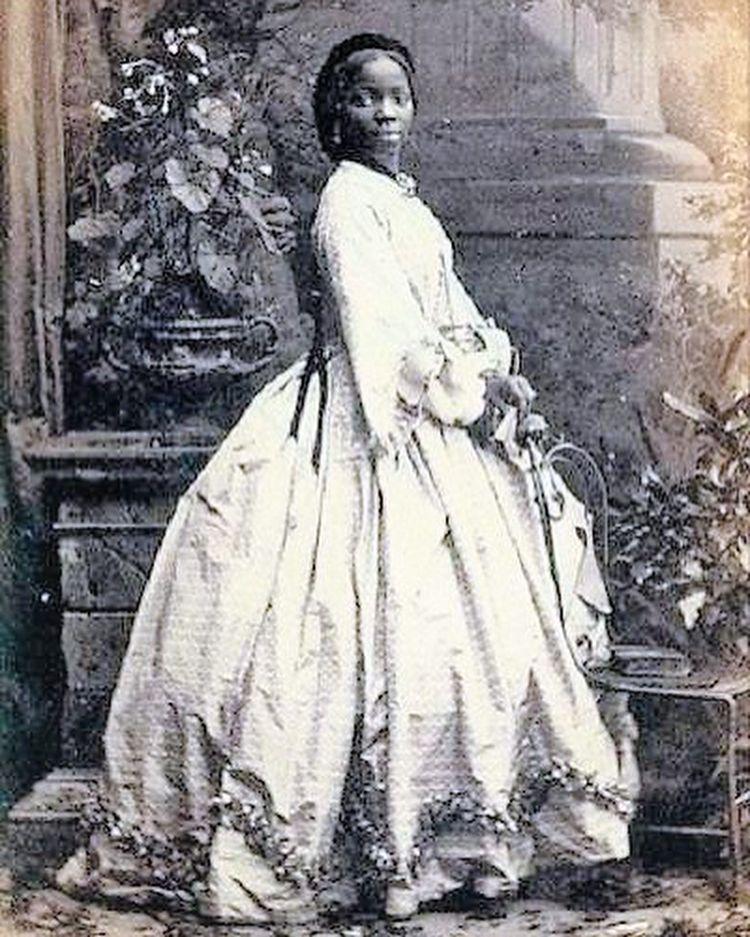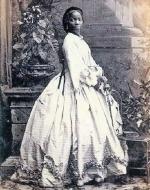Created by Bethany Kujawinski on Fri, 10/23/2020 - 11:23
Description:
The photograph above was captured by the renowned photographer Camille Silvy, and it displays Sarah Forbes Bonetta in her wedding dress at St Nicholas Church in Brighton, England (“Sarah Forbes Bonetta (Sarah Davies).”). Camille Silvy began photography midway through his life after he already studied law to become a diplomat, and eventually he became so successful in the photography business that he became a part of the French Société Française de Photographie as well as the London Photographic Society (“Camille Silvy (French, 1834 - 1910) (Getty Museum).”). His success came from his landscape photographs of a countryside in Paris where he had grown up (“Camille Silvy (French, 1834 - 1910) (Getty Museum).”). He was able to get enough money to open a studio in London where he photographed many men and women of high status from around the world including, but not limited to: Queen Emma of Hawaii, Princess Mary Adelaide of Cambridge, and Queen Victoria’s Goddaughter Sarah Forbes Bonetta who is pictured above (“Camille Silvy.”). Silvy was known for taking photographs of many members of the British Royal family as well.
It is important to note that when photography first came into existence it was primarily available for the rich and upper-class citizens because producing a photograph was extremely timely and expensive. Around the 1850’s, photography became cheaper with Frederick Scott Archer’s invention of the wet collodion process (“Victorian Photographic Techniques.”). However, photography still remained mainly for those in the upper-class and was meant for special occasions like family portraits and weddings.
When analyzing the photograph of Sarah Forbes Bonetta more closely, you can see a lot of similarities between Sarah’s wedding dress and that of typical Victorian wedding gowns. The wavy ruffles at the bottom of the dress were very typical of Victorian wedding fashion as well as the full nineteenth-century skirt that covers crinolines and petticoats (Brennan). Despite the placement of her arms covering her middle, one can still observe the way the dress pinches in to flatter her slim waist which is most likely supported by a corset. Sarah’s pose gives off an air of confidence with a straight posture, shoulders back, and her eyes looking directly into the camera. The viewer can tell from this pose that she is refined and has had practice holding this position before whether it be for a painting or a photograph.
Although the picture is black and white, the viewer is still able to tell that the dress is white. This is due to the fact that in the Victorian era it was believed (and is still believed to an extent) that, “white is the most fitting hue [for brides], whatever may be the material. It is an emblem of the purity and innocence of girlhood, and the unsullied heart she now yields to the chosen one” (Brennan). The white wedding dress is meant to represent innocence and virginity more so than wealth or class status.
Both Sarah and her husband are from African countries, but their attire for their wedding resembled that of a Victorian style. She is shown in this image wearing a traditional Victorian gown and he, as seen in other images, sports a very European-style suit. While the couple may have dressed in a Victorian fashion, the viewer can see that Sarah’s hair appears to be in two coiled braids, with the rest of it wrapped into a low bun that rests on the back of her neck. It is difficult to tell due to the graininess of the photograph, but later depictions of the image show that she is wearing a flat black cap or scarf at the top part of her head. It looks almost as though it is a part of her hair due to the black and white photo. This was not as common a style in English weddings during the Victorian era since most brides wore their hair completely back in a low bun. However, this hairstyle did slightly resemble that of the brides from Nigeria (where Sarah was born) since most brides there wore their hair in geles, which is a scarf that is folded into an ornate shape and worn atop a woman’s head (Olanrewaju). It would appear as though she took some form of hairstyle from her home country of Nigeria and where she grew up in England and then mixed the two styles, hence the flat black cap/scarf mixed with the low bun.
Works Cited:
Braimah, Ayodale. “Sarah Forbes Bonetta (1843-1880).” Blackpast, 30 Jan. 2020, www.blackpast.org/global-african-history/bonetta-sarah-forbes-1843-1880/.
Brennan, Summer. “A Natural History of the Wedding Dress.” JSTOR Daily, 27 Sept. 2017, daily.jstor.org/a-natural-history-of-the-wedding-dress/.
Bressey, Caroline. “Of Africa's Brightest Ornaments: a Short Biography of Sarah Forbes Bonetta.” Taylor & Francis, 21 Apr. 2010, www.tandfonline.com/doi/abs/10.1080/1464936000074675.
“Camille Silvy (French, 1834 - 1910) (Getty Museum).” The J. Paul Getty in Los Angeles, www.getty.edu/art/collection/artists/1532/camille-silvy-french-1834-1910/.
“Camille Silvy.” Wikipedia, Wikimedia Foundation, 28 Sept. 2020, en.wikipedia.org/wiki/Camille_Silvy.
Forbes, Bart. “Sarah Forbes Bonetta.” Clan Forbes Society, 7 Aug. 2020, www.clan-forbes.org/post/sarah-forbes-bonetta.
Myers, Walter Dean. At Her Majesty's Request: an African Princess in Victorian England. Scholastic Press, 1999.
Olanrewaju, Adenike. “The Fabric of Nigerian Weddings.” The New York Times, The New York Times, 20 Aug. 2019, www.nytimes.com/2019/08/20/fashion/weddings/the-fabric-ofnigerian-weddin....
“Sara Forbes Bonetta.” Wikiwand, 2020, www.wikiwand.com/en/Sara_Forbes_Bonetta.
“Sarah Forbes Bonetta (Sarah Davies).” National Portrait Gallery, 2014, www.npg.org.uk/collections/search/portrait/mw66053/Sarah-Forbes-Bonetta-....
“Victorian Photographic Techniques.” National Museums Scotland, www.nms.ac.uk/explore-our-collections/stories/science-and-technology/vic....


